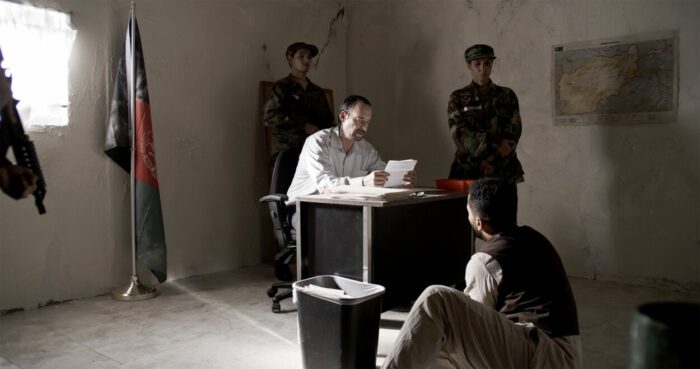I Am Gitmo, a dramatized account of an innocent man’s imprisonment and torture, has an important truth to tell. In the wake of 9/11, Middle Eastern men like the film’s protagonist, Gamel, were sold to the CIA for a bounty, their presumed culpability in terrorist acts never verified. Almost 800 of them were later sent to Guantánamo Bay, where they were interrogated and tortured for days, weeks, months, and even years, most of them never formally charged. I Am Gitmo‘s account of one man’s experience there is composited from the declassified legal hearings of detainees and told largely from the perspective of the victims of the U.S. “War on Terror.” Despite earnest performances from its two leads, the film’s intentions are undercut by its compromised script, wobbly direction, and unconvincing supporting cast: I Am Gitmo‘s is a story worth telling, but one that deserves a better presentation than this.
The film open’s with the arrest of Gamel Sadek (Sammy Sheik) in Kandahar, Afghanistan, where he lives with his wife and children. That—and his proclaimed innocence—is all we are given to learn of the man with whom we will spend the next two hours. Anyone wrongfully accused deserves sympathy, but I Am Gitmo overlooks simple characterization: we know Gamel only as a man professing his innocence, and nothing more, save for some voice-over professing his faith in Allah and love of his family. Sheik (American Sniper, Dune Part 2) is fine actor but saddled with little to do other than wince in torture in one scene and then and profess his innocence in the next, again and again.

Retired Army interrogator John Anderson (Eric Pierpoint) is assigned Gamel’s case. Equally devout in his faith and devoted to his government’s cause, John is wary of the methods being used to break down the suspected Jihadists, including waterboarding, physical beatings, sleep deprivation, prolonged constraint in uncomfortable positions, hooding, cultural and sexual humiliation, and other psychological and physical torment. His is not a “White Savior” role: though he professes his distaste for the methods used to torture Gamel and others, he does literally nothing about it other than grumble—and, like Gamel, his characterization is often subordinated to voice-over, his in the form of lifeless letters narrated to his daughter, in a tactic that begins to feel quickly like a narrative crutch.

© I Am Gitmo/Cinema Libre Studio
The lack of strong characterization of either lead is compounded by a wobbly script that aims to depict the full gamut of torture methods deployed at Guantánamo. So there is, necessarily, a beating scene. Later, waterboarding. After that, electric shock. Then sleep deprivation and closed confinement. Then sexual humiliation and defilement. I’m skipping a few. That all of these were employed in the service of interrogation is a violation of human rights, but in I Am Gitmo the scenes feel more like an inventory of methods than an evolving narrative. It doesn’t help that the film’s modest budget delimits what can be conveyed, but the scenes themselves are often unconvincing, as is the supporting cast assigned to depict them: Gamel’s “beating” looks like a battery of love taps, for instance, and the props and sets do little to create a sense of verisimilitude. (Nearly 80 years ago in Rome, Open City, Roberto Rossellini proved how intense a torture scene could be without actually depicting the act—a technique that could have worked well here were it not for the intent to catalogue every unjust method of torture.)
Some detainees at Guantánamo were held over a decade. And as Gamel’s case lingers on without resolution—Gamel will not yield and John can elicit no evidence of guilt—a human rights lawyer, Robert Levin (Paul Kampf), takes on the case. Levin’s strategy is to have Gamel’s status as an “enemy combatant”—which allows for his indefinite detainment—reviewed and revoked. Without spoiling the plot, I’ll note that it’s an oddity of the script that its third-act hearing does not directly resolve the conflicts for either of its principals; any resolution is left instead to a brief post-script epilogue.

That I Am Gitmo tackles an important subject on a modest budget is to be admired. What occurred at Guantánamo Bay in the aughts and tens is well documented in the courts and media reportage but only rarely yet the subject of cultural storytelling. The Mauritanian addressed the case of Mohamedou Ould Salahi with aplomb. The current season of the popular podcast Serial explores the development and operations of Guantánamo Bay, now one of the world’s most notorious prisons. There’s room for more films, series, and episodes to convey the truth of the torture that occurred there.
And the story is not over. Of the nearly 800 detained at Guantánamo Bay, 30 remain as of this writing, 11 of them charged with war crimes, and of those, one—just one—has been convicted. Others still await trial or are held in indefinite detainment without facing charges. I Am Gitmo may not satisfy as a dramatic narrative—its faults are too glaring and too many to do so—but the story it tells is one the world still needs to hear.



